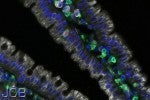 What spurs the human immune system into action when there’s a parasitic infection in the gut? A new study finds that special cells called tuft cells play a big role—by “tasting” the presence of intestinal parasites and setting the immune system into motion against them.
What spurs the human immune system into action when there’s a parasitic infection in the gut? A new study finds that special cells called tuft cells play a big role—by “tasting” the presence of intestinal parasites and setting the immune system into motion against them.
The finding, outlined in a paper published February 2, 2016 in Science, is important, said senior author Wendy Garrett, Melvin J. and Geraldine L. Glimcher Associate Professor of Immunology and Infectious Diseases at Harvard T.H. Chan School of Public Health. Knowing more about the interplay between tuft cells and the immune system could help scientists develop new ways to treat parasitic diseases such as giardiasis, roundworm, and hookworm, which afflict millions around the world— particularly children—and cause debilitating symptoms such as diarrhea, nausea, vomiting, bloating, and pain, and contribute to weight loss and malnutrition.
Scientists have known about tuft cells, which have stiff bristles and stick out from the intestinal wall in clumps, since the mid-1950s. But until recently their function has been unclear.
Garrett’s study was one of three recent studies to shed new light on tuft cells. “It’s pretty cool that three groups uncovered different information about these cells at the same time, just by chance,” she said. “We all found that tuft cells play an important role in the immune system.”
Garrett’s lab focuses on the interplay between the gastrointestinal immune system and the microbes that live in the gut in health, inflammatory bowel disease, and colorectal cancer. For the new study, she and her team—including lead author Michael Howitt, a research fellow—showed that although tuft cells can’t actually “taste” things, they do use a process called “taste chemosensation.” This is similar to the process by which taste buds on the tongue detect different flavors such as sweet, savory, or bitter. In the gut, this process enables tuft cells to detect parasites such as protozoa and helminths (worms), and to then send out signals to other cells to jump-start an immune response.
Tuft cells “are sentries, at the front line of whatever’s coming through your intestinal tube, poised to help fight parasites,” Garrett said.
The researchers were able to pinpoint tuft cells’ function by comparing two groups of parasite-infected mice. The mice in one group lacked key proteins that tuft cells use to send messages to other cells. After five weeks, the mice without the protein had more worms than the other mice. The normal mice also produced additional tuft cells and had higher levels of interleukin-25, a protein that triggers immune responses to parasites.
Infections caused by protozoa and helminths are typically treated with antiparasitic medications. But the new finding might help lead to alternative treatments, Garrett said. “If we can figure out how to engage ‘taste chemosensation’ in the tuft cells—in essence, to figure out what the parasites are making that the tuft cells are ‘tasting’—maybe we could help rev up the immune system,” she said.
Garrett added that she is excited about the implications of her group’s new finding. “That parasite-derived molecules can be tasted—and that tuft cells in the gut do this—gives us new perspective about how our bodies interact with the microbes in our world,” she said.
— Karen Feldscher
Image courtesy François Gerbe. Reference: Gerbe et al. (2011) J. Cell Biol. 192, 767-780. Published on: March 7, 2011. doi: 10.1083/jcb.201010127. License: CC BY 2.0
To see the original article, please click here.



